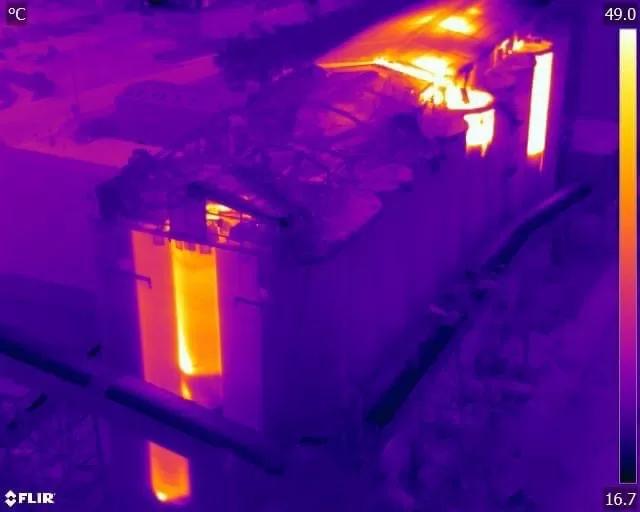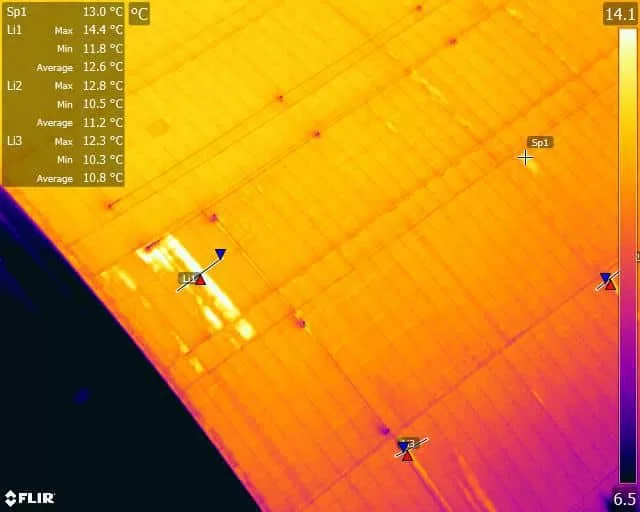Aerial Thermography – Certified Level 3
Drone Thermal Imaging & Infrared Inspections
Detect Heat Loss, Electrical Faults & Structural Anomalies with Precision Infrared Imaging
Certified Level 3 Master Thermographers | CAA-Approved Operations | UK-Wide Aerial Thermal Inspections
Drone Media Imaging provides professional aerial thermography for commercial buildings, industrial facilities, solar PV arrays, and electrical systems across the UK. Using radiometric thermal drones and advanced infrared workflows under Level 3 thermographic certification, we deliver accurate, standards-driven thermal inspections that reveal heat loss, electrical faults, moisture pathways, and structural anomalies quickly, safely, and without disruption.

Aerial thermography enables high-accuracy detection of temperature anomalies across large structures, roofs, façades, and industrial assets. With radiometric thermal sensors, we capture precise temperature data that identifies insulation failures, thermal bridging, water ingress, electrical hot spots, mechanical overheating, and energy inefficiencies invisible to the naked eye.
Because our thermal surveys are carried out with the oversight and interpretation of a Certified Level 3 Thermographer, findings are analysed using correct emissivity modelling, environmental validation, and accepted thermographic principles. This ensures results are not only visually clear, but technically reliable, repeatable, and suitable for engineering, maintenance, or compliance documentation.
By using drones instead of manual access methods, surveys are completed faster, without working-at-height risks, and with significantly less operational disruption. This makes aerial thermography ideal for commercial estates, solar farms, industrial facilities, energy sites, and buildings where conventional thermal surveys are impractical or unsafe.
Unlock precise thermal insights with certified aerial thermography designed to identify hidden faults, improve energy efficiency, enhance safety, and support compliance across commercial, industrial, and solar PV assets.


What Aerial Thermography Provides
Certified Master Thermography Level 3
Aerial thermography enables high-accuracy detection of temperature anomalies across large structures, roofs, façades, and industrial assets. With radiometric thermal sensors, we capture precise temperature data that identifies insulation failures, thermal bridging, water ingress, electrical hot spots, mechanical overheating, and energy inefficiencies invisible to the naked eye.
Because our thermal surveys are carried out with the oversight and interpretation of a Certified Level 3 Thermographer, findings are analysed using correct emissivity modelling, environmental validation, and accepted thermographic principles. This ensures results are not only visually clear, but technically reliable, repeatable, and suitable for engineering, maintenance, or compliance documentation.
By using drones instead of manual access methods, surveys are completed faster, without working-at-height risks, and with significantly less operational disruption. This makes aerial thermography ideal for commercial estates, solar farms, industrial facilities, energy sites, and buildings where conventional thermal surveys are impractical or unsafe.
Who This Service Is Designed For
This service is designed for organisations requiring verified thermal diagnostics to support maintenance decisions, compliance, safety assurance, and planned refurbishment.
Our aerial thermography services support:
How We Deliver Thermal Inspections – Technical Methodology
Our thermography workflow is grounded in industry-recognised standards including ISO 18436-7, ISO 9712, and EN 13187, ensuring every survey is executed with correct measurement parameters, flight geometry, and environmental validation. We capture radiometric thermal imagery using calibrated sensors (DJI XT2 / M4T), with consistent temperature range settings, RAT/Tref adjustments, and controlled emissivity values based on surface materials.
Flight planning ensures optimal angle, height, and GSD for the asset being surveyed, minimising reflectivity, ensuring stable thermal contrast, and capturing data suitable for detailed interpretation. For buildings, we ensure correct thermal loading and nighttime capture windows; for solar PV, we adhere to IEC 62446-3; for electrical systems and industrial assets, we ensure safe standoff distances and controlled viewpoints.
Following acquisition, thermal imagery is processed in professional software to produce radiometric temperature reads, annotated findings, thermal overlays, and structured commentary. With Level 3 analysis, we differentiate between environmental artefacts, emissivity-driven illusions, true fault signatures, and material behaviour — ensuring accurate and defensible conclusions.
Who This Service Is Designed For
This service is designed for organisations requiring verified thermal diagnostics to support maintenance decisions, compliance, safety assurance, and planned refurbishment.
Our aerial thermography services support:


What Aerial Thermography Can Detect?
Certified Level 3 Master Thermographers – The Highest Qualification in the Industry
Aerial thermography reveals thermal patterns and temperature anomalies that are not visible during traditional inspections. Using radiometric thermal imaging, we identify issues such as heat loss, insulation defects, thermal bridging, air leakage, and potential moisture pathways within building envelopes and flat roofing systems. These temperature variations help pinpoint hidden failures that contribute to increased energy costs, internal discomfort, and long-term structural deterioration.
For solar PV systems, thermography provides a fast and accurate method of detecting module-level and string-level defects including hotspots, cracked cells, PID, bypass diode failures, shading issues, and thermal inconsistencies across arrays. These findings offer early indicators of performance losses, electrical imbalance, or mechanical degradation—allowing O&M teams to act quickly and protect system output. When combined with string-level electrical testing, thermal data becomes even more powerful, delivering a comprehensive performance profile of the entire PV system.
In industrial and electrical settings, aerial thermography helps identify overheating components, high-resistance connections, mechanical friction points, failing bearings, and equipment operating outside of expected temperature ranges. These thermal signatures often indicate emerging faults long before they cause operational downtime or safety risks. With high-accuracy radiometric data and Level 3 interpretation, aerial thermography provides a reliable method of detecting faults early, supporting planned maintenance, compliance auditing, and safer operation across commercial and industrial sites.
What Aerial Thermography Can Detect
Aerial thermal inspections uncover a wide range of issues, including:
FAQs – Aerial Thermography
Aerial thermography is used in construction, energy, electrical, industrial, and environmental sectors to detect heat loss, electrical failures, and system inefficiencies.
Costs depend on site size, complexity, and reporting requirements. Contact us for a tailored quote.
Our high-resolution infrared cameras capture precise temperature variations, ensuring detailed and reliable thermal analysis.
We detect roof leaks, insulation failures, electrical faults, overheating machinery, solar panel defects, and HVAC inefficiencies.
For preventative maintenance, we recommend annual inspections, or more frequently for high-risk industrial assets.
Yes, our detailed thermal inspection reports include analysis, identified issues, and expert recommendations for repairs or efficiency improvements.
Yes, our IEC62446-3:2017 compliant thermal imaging detects hotspots, cell degradation, and performance inefficiencies in solar panels.
Yes, nighttime inspections often improve thermal contrast, making faults more visible.
Absolutely! Thermal imaging data provides evidence of faults and structural issues, supporting insurance claims for damage assessments and energy efficiency disputes.
Yes! We are CAA-certified drone operators and adhere to industry standards and safety regulations.




